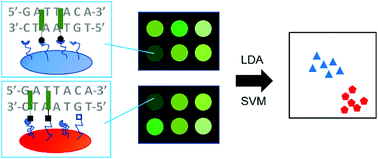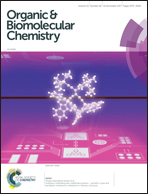Differential array sensing for cancer cell classification and novelty detection†
Abstract
A series of semi-specific peptides reported in the literature to bind various epitopes on cell surfaces were used in a differential sensing array to pattern cell line identity. The peptides were conjugated to thiazole orange to act as both a fluorescence reporter and a DNA intercalator. Fluorescence data for the peptides exposed to cells, with and without exogenous double stranded DNA (dsDNA), led to chemometric fingerprints for eight cancer cell lines. In contrast to the use of structures meant to act in completely non-specific ways, the use of a limited level of specificity generated linear discriminant score plots with high dimensionality, i.e. several principle components carrying significant variance. The arrays were found to correctly classify the cell lines from 60% to 100% depending upon the cell line. Due to the high dimensionality score plots, the identification of cell lines that were not part of the training set was examined. Support vector machines were used as a novelty detection routine and showed that a cancer line not part of the original training set could be correctly identified as being novel.

- This article is part of the themed collection: Chemosensors and Molecular Logic


 Please wait while we load your content...
Please wait while we load your content...